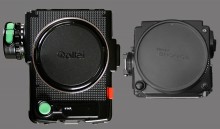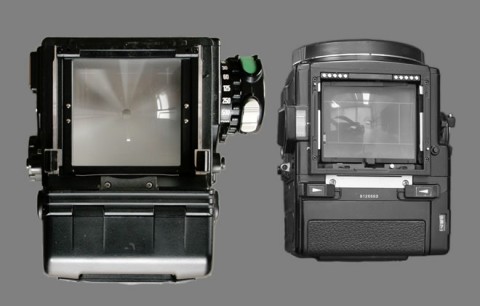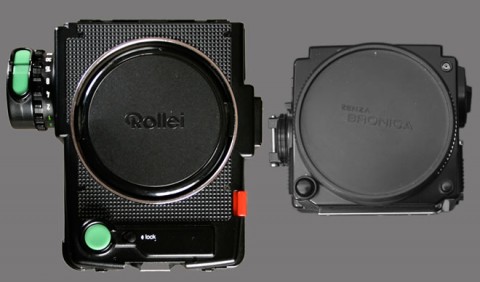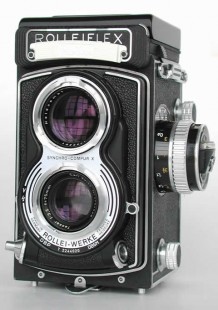I have recently sold my Rolleiflex 6008 AF outfit in favour of Bronica. Now I know that this would appear to be heresy to even suggest this, never mind actually doing it. I am still a Rollei enthusiast. My outfit consisted of a 6008 AF body with three 4560 magazine backs, 40mm f3.5 Super Angulon, 60mm f3.5 Distagon, 90mm f4 Makro Apo-Symmar, 150mm Rolleigon and a x 2 converter, plus of course small accessories. The estimated value of this was about £6,500 retail. What it is worth retail is one thing, actually selling at retail is another. Using E-bay yields less money but you get the money NOW. You can tilt the odds in your favour. Christmas is a bad time, as people don’t have the money. Likewise, in mid summer, thoughts of Spain etc. take precedence over photo gear. Spring is a good time. Of course, if you need to buy then the reverse is true. The cost of a similar Bronica ETR-Si outfit was less than £1,500. Now I am 63 and have ‘old age’ to contend with (I hope!). I have also noticed that as I get older, carrying heavy equipment is becoming very tiresome pushing the use of a Rollei 6008 definitely into a ‘back seat’. The camera is not particularly heavy in itself but try carrying it around for an afternoon then you realise just how heavy it really is. If you are going out with the specific purpose to take photographs, that is one thing, but taking a camera as a matter of course on a shopping trip then that is something quite different. I also find TLR’s quite bulky as well and much prefer a 35mm range-finder camera, such as the Rollei 35RF, if I have got to walk far. One of my photo friends, who sadly died last year, had about six TLR’s. He loved them. But he did say that if he were only allowed one camera, then this would be his Agfa Super Isolette as it was light and folded almost flat and gave excellent results. However, the potential sale of the Rolleiflex 6008 brings thoughts of having £4000 cash and was very tempting. I am not a professional photographer just an enthusiastic amateur and I cannot justify such a large amount of money on a hobby. When I bought a 6006, it was barely dearer than a Bronica but not any longer. Bronica had ceased trading about seven years ago causing the second-hand value to plummet. I was also frightened that the second-hand value of Rolleiflex SLR’s might go the same way.
Now, what prompted all this was one of the 4560 backs, which had a split in the laminar draw-slide. Several years ago, I had bought a 6 x 6 back which had a similar problem.
The cost of repair for the 6 x 6 back was about £80.00 - a tidy sum but not unmanageable. I expected the repair of the 4560 back to be more, allowing for the five-year interval and the change of the exchange rate, I expected no more than £150.00. Not so. The repair cost was a staggering £320.00. Fortunately my friend intervened and for £220.00 I got the repair plus a battery pack re-celled. At that time for £299.00, Ffordes were selling a Bronica ETR-Si with AE II prism, back and 75mm PE lens. Before I bought anything I made several enquiries as to the general handling etc. I did contact Intro 2020 (the agents) over this and I spoke with a Mr. Takahashi who was most pleasant and very helpful. He told me only to buy lenses marked PE. He asked me if I had heard of ‘Hassebrad’ and Zeiss optics. He said that the PE range were the equal of Zeiss. Ivor Matanle had said this in one of his articles on ‘Classics to Use’. Mr Takahashi also suggested that the SQ system might be better as it is 6 x 6 like the Rolleiflex AND the backs could be interchanged without remembering to change the film speed. Whilst this is true, the SQ is a bigger camera and the size and weight of these things were also important. If any of you have products sold by Intro 2020 and need service or advice (Tamron and Gossen) then Mr. Takahashi is the man to contact (or his wife Andrea). They don’t charge the ‘earth’ either. A service on an ETR-Si was just less than £50.00 including VAT and return postage. The telephone number is 01628 799902. Mr Takahashi may well answer the phone himself.
Just after the magazine back fiasco, Rollei went bankrupt. This perhaps was the reason for the high cost of the repair of the 4560 back in the first place. Schneider told me that they could only do repairs on the optics on my 40mm and 90mm but not on the electronic shutter. Zeiss were even worse and could not offer any service at all on the 60mm. If Rollei were still in existence they could have repaired the shutter/aperture assembly, which is the bit that is most likely to fail but these are made ‘in house’, so when Rollei ‘went’ so did these units. I am told that these units are good for 100,000 exposures which spread over four lenses is about 400,000 exposures. I have since emailed the factory twice but did not get a reply in either case. The Rollei factory has started up again under the name of DHW Fototechnik. Now, since it is a new company they ‘could’ deny service for all products relating to Franke and Heidecke. This was a deciding factor to sell before the price fell through the floor. Denying service on older models is quite usual. There was a BMW motorcycle dealer here in Liverpool who lost the agency. He then sold Russian BMW copies. Then BMW asked him to take the agency back, which they did, but ‘only carried spares for bikes that were current as they had only been agents for six months’, thereby washing their hands of all previous models! This ‘new’ Rollei company could do the same. Having thought about all this I decided that it was time to sell. I still have two SL35’s and three Rolleicords so I am not Rollei-less.
Having got the Bronica, I am very pleased with it BUT it was not without problems. The body needed a service as the ‘ERR’ message came up so regularly it was unbelievable. The metered prism (AE III) was ‘way out’. There was a 105mm macro lens with a sticking shutter, which also needed attention. The total cost for the three items cost under £200.00 to service. The body and the lens came from the USA, and both vendors were happy to go ‘halves’ with me. The original price of the lens was about half price but I was unlucky, as H.M.R.C. wanted their tax cut amounting to £60.00. The Prism came from a dealer in the UK, who had by now paid the money to the owner of the prism (commission sale), but offered a good discount on future purchases! The plus point was it was about £30.00 cheaper than two others I had seen, so taking this into account, a service with a six month guarantee worked out at £22.66 which wasn’t bad at all.
Compared with a Rolleiflex it is rather basic. The film speed is on the prism finder so you have to remember to change the speed if you interchange the backs! Having said that, to do this is a lot easier than changing the film speed on a 6006, which is one of the reasons why I bought a 6008. You could always use (where possible) films of the same speed (B&W and colour reversal). The camera does not have a motor drive, although one is available should you need it. It does not have a laminar draw slide but conventional dark slides. Having removed the dark slide there is no place to store it on the camera! The ‘speed grip’ is superb, having a lever wind like a 35mm camera, although you need to crank it twice as on an early Leica M3. As a hand held/monopod job it is ‘nice’ for landscape mode shots but a little awkward for portrait mode shots. If you use a tripod and use the mirror up facility you need to think. The ETR-Si has mirror up but previous models do not, hence my choice of this model. With Rollei the sequence is as follows:
- Compose picture
- Lock meter
- Mirror up
- Make exposure
- If you change your mind remove back and release shutter, and replace back.
- Unlock meter ready for the next shot.
With the Bronica the sequence is as follows:
- Compose picture
- Lock meter
- Mirror up
- Make exposure
- MIRROR DOWN before you proceed to 6..
- Wind on.
- If you change your mind you have to put the mirror-up lever back down. Then utilise the double exposure lever, which is ’inconveniently’ placed behind the speed grip. You need a biro or pencil to push it with (either that or thin fingers or long nails). You then wind on and make your exposure.
You should then REMEMBER to de-activate the double exposure lever. The same thing applies if you wind on before returning the mirror up lever to its normal position. Removing the back (as on the Rollei) does not work. You still have to utilise the double exposure lever. The meter automatically unlocks having made the exposure.
If you need to take a shot in portrait mode you have to turn the camera to a vertical position which is not as easy as using a Rollei 6 x 6. If you use the Rollei 4560 back you merely remove the back and turn it through 90 degrees. Now this brings me to my problem with the split laminar draw slide. I did consider the split to be caused by excessive use. On a 4560 back the draw slide will be used a lot more than on a standard interchangeable 6 x 6 back. It looks to be a simple thing to replace but from where do you obtain one?
The viewfinder of the Rollei tells you everything you need to know. Even the word ‘Slide’ comes up if you have not operated the laminar draw slide. The Rollei is a multi-mode camera whereas the Bronica is only aperture priority/manual (which is all I ever use anyway). The Bronica tells you the shutter speed, spot/centre weighted metering, lock on the meter but that’s it. It does not tell you which aperture, frame number film speed etc. That is not that important to me but may be to some people. You are advised in the Bronica manual NOT to carry the camera with the dark slide in situ as the back can accidentally come off !!!! This IS true. Twice I have come to get the camera out of the bag to find the back loose in the bottom. Also you should not be able to take a frame with the dark-slide in situ but with some backs that I have, you can do this! I will have to sort out which are which. You can also take a shot with the dark-slide partially withdrawn, ending up with a frame measuring 10mm x 42mm! The backs are very cheap at £20-£50 each compared with £350.00 for a 4560 back or £100 for a 6 x 6 back from Ffordes. Ffordes sold me a Bronica back for only £29.00. I only ‘need’ two maybe three but have ended up with five owing to ‘deals’.
The bayonet mount works in the opposite direction to Rollei, as does the focussing mount, which is something you have to get used to. It is logical to unlock a bayonet by turning it anti-clockwise. The Bronica is the opposite way around, but then so are Nikon and Contax range-finder cameras. If you put a converter on the camera there is a green dot on the camera side of the converter. This is opposite a slot with a peg sticking out. This peg has to be cranked with your finger so that it is opposite the green dot. If you don’t do that, the converter will not go on to the lens. Once the whole assembly is on the camera you cannot remove the lens on its own leaving the converter on the camera. The whole assembly has to be removed. A pin in the back has to be pressed to release the lens from the converter. This may sound somewhat inconvenient, but with the Rollei, the manual tells you NOT to put the converter on the camera then the lens on to the converter but to place the whole assembly on the camera. Rollei place little emphasis on this as such. I suspect that it is to do with the electronics. That red release button on the camera switches the camera off but the release button on the converter does not! A possible short circuit resulting in damage? If you turn the camera off I suppose that you would be OK.
On the top of the Bronica magazine backs there are two lugs for opening the back. These are not far off being in the same position as the buttons on the Rollei 6 x 6 for removing the standard 6 x 6 back. Yes, I opened one accidentally! However, it is not all negative. You cannot remove the Bronica lens with the mirror up whereas with a Rollei (6008 Professional anyway) you can! All in all, you have to think when using the Bronica. I have conditioned myself into the correct sequence especially when using mirror up.
Conclusion: If you have the money, then the Rolleiflex is probably the most advanced medium format camera available. It is simply superb. It is almost foolproof and when working at speed it is difficult to make an error. It has aperture priority, shutter priority, manual, programme, centre weighted metering, spot metering and additive spot, plus many other features. However, it is quite heavy compared with a Bronica, not to mention its size and cost. I reckon a saving of at least 800 grams with a body two backs, prism, 40mm and 60mm lenses. The two Schneider zoom lenses and the 55mm PC lens, which are available for the Rollei, are also available in Bronica mount, as well as Bronica’s own zooms. The results so far are as good as with the Rollei, but I suspect that the ultimate testing of equipment might put the Rollei ahead. But at the end of the day, can you see the difference in a finished print? Probably not.



